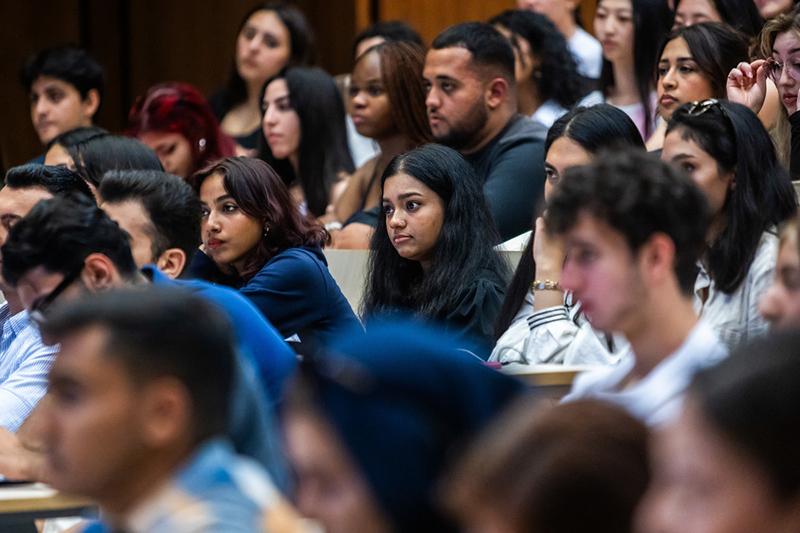Having taught international courses in higher education for 15 years as a cultural anthropologist, I assumed that my background knowledge, sensitivity and commitment would enable me to manage diversity in the classroom. Although I seemed to be doing well on certain measures, I came to realise that my unconscious bias was quietly cheating me.
Here, I offer my insights around “interculturality” and practical tips for handling difficulties arising from cultural diversity in a classroom environment:
Communication barriers and using English as a technical language
Most of us who have international teaching experience would agree that language is one of the main obstacles to creating an ideal teaching and learning environment. Language is both a tool for communication and an anchor for individual learning pathways.
- Collection: English as a second language in higher education
- How to teach clinical communication skills in a foreign language from scratch
- How to support multilingual international students in the classroom
Although we all speak the same language in the classroom (English as a technical language), the culture in which students were raised influences how concepts are embedded and related. In other words, previously acquired knowledge may mean different things to different people, and the differences can cause problems during university years. This is not only important in the humanities but also in certain fields of natural sciences.
The greatest challenge is therefore to establish a general framework to enhance shared understanding. Barriers usually arise in how students from different backgrounds engage in the process of developing understanding. Hence, I would like to focus on what happens between the instructor and the students in the classroom or, in other words, how the space between them is shaped and what this space can be used for.
‘Interculturality’ as a culturally dependent concept
In simple terms, we are interculturally competent when we can overcome the difficulties posed by cultural differences. When a lecturer is confronted with cultural differences in the classroom, they may consciously use the concept of interculturality in the form of competence development and pay close attention to the language used. Doing this in a yielding way, it should not be limited to competence development or language used. Based on my experience, and in conjunction with the critical or reflective approach to interculturality, I would stress that how we understand the term interculturality itself is strictly linked to our underlying beliefs. For instance, students might see the role of the lecturer differently depending on their culture, resulting in a diverse understanding of the power balance in the classroom.
Descriptive v prescriptive interculturality: which one suits our needs?
Interculturality can be understood and applied in two senses: descriptive or normative.
The descriptive sense refers to a process in which at least two people from different cultural backgrounds interact and negotiate to understand each other. In this case, ambiguities and uncertainties are more acceptable or tolerated as part of a never-ending process. This approach may not be the most appropriate or effective for many educational purposes. For example, when talking about end-of-life ethical questions in medical classes, highlighting and accepting the role of beliefs in various communities gives space for open discussions, but with no pressing need to come to an agreement.
In contrast, when interculturality is perceived in the normative sense, it gives rise to other communication strategies during classes. Interculturality in this sense does not mean imposing a solution that everyone must accept but suggests that the parties need to arrive at an “agreement”. The concepts that emerge from these agreements provide a common basis for learning. This approach urges and demands, among many things, a common understanding of the subject matter. Continuing the example above: understanding why we accept beliefs only to a certain extent when we discuss social norms regarding end-of-life issues in a bioethical context is crucial for students who wish to practise their professions in our community. When assessing success, we tend to measure the extent to which this agreement has been achieved (that is, whether the knowledge or message has been adequately conveyed or communicated to the student).
Distance as the central element of intercultural encounters
Choosing wisely between these intercultural strategies has a great benefit in a classroom environment. We can focus on what we are talking about without concentrating too much on the parties involved. The process of dialogue among the parties is at least as important as the truth of what is being said. In addition, the possibility that the other person may be right should always be kept open. In this way, interculturality can be seen not as a condition but as a methodology. The discussion partners may interpret and apply interculturality in different ways, but once the cultural distance has been identified, it can create space for open discussion in the language that best suits both parties.
Interculturality as methodology: useful advice for teachers
These practical tips may help educators manage difficulties arising from cultural diversity in the classroom:
- Exploit the advantages of being a non-native speaker. If both instructor and student use English as a foreign language (EFL), it can make it easier to develop a common language. Try to accept that what is intended to be said is more important than how it is said.
- Encourage your students to think creatively and critically, rather than emphasising a single interpretation. Recognise that the other person may be right. Without acknowledging the possibility that a student might be right, your entire intercultural endeavour will be on the wrong track. No one can leave room for open discussion if the outcome has been decided from the beginning. Focusing on the space between interlocutors and on the subject matter helps maintain this position and can enrich everyone involved.
- Readiness to change is a key and useful quality for a lecturer in intercultural situations. It may require a strong self-awareness and a clear understanding of the situation, but if an educator can be open to change, they will not only discover new perspectives but can also become a role model for students who wish to learn reflective and critical thinking.
Attila Dobos is senior lecturer in the Faculty of Health Sciences at Semmelweis University, Budapest.
If you would like advice and insight from academics and university staff delivered direct to your inbox each week, sign up for the Campus newsletter.




comment